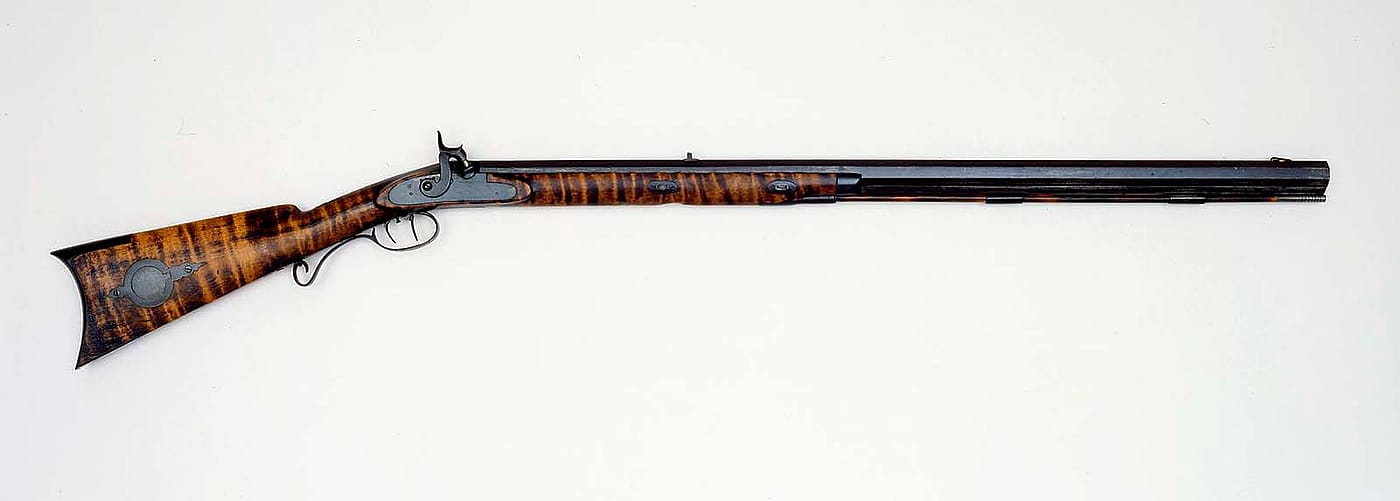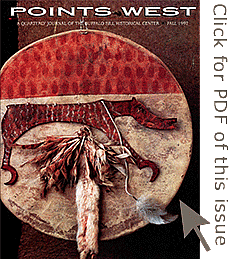
Hawken Tradition: Important Hawken Rifle Collection Donated in 1997 – Points West Online
Originally published in Points West magazine
Fall 1997
Hawken Tradition: Important Hawken Rifle Collection Donated to Buffalo Bill [Center of the West]
Willam B. Ruger, Sr., Sturm, Ruger and Company ensure Hawken Collection remains at Center in perpetuity
By Howard Michael Madaus
Former Robert W. Woodruff Curator of the Cody Firearms Museum
An important group of the rifles that became famous during the Rocky Mountain fur trade period has found a permanent home at the Buffalo Bill [Center of the West], thanks to the generosity of Trustee William B. Ruger, Sr. and Sturm, Ruger and Company.


In the early 1970s, Cody Firearms Museum Advisory Board member Dr. Kenneth Leonard loaned a collection of western-associated firearms to the Center. The collection was initially displayed in the Buffalo Bill Museum, but as other wings were added to the Center, it was dispersed to areas where it could best tell the story of firearms in the American West. Some stayed in the Buffalo Bill Museum, others were integrated with the exhibits of the Plains Indian Museum when it was added in 1979, but most were housed in the Winchester Arms Museum after the Olin Corporation loaned its New Haven collection to the Center in 1976.
With the completion of the Cody Firearms Museum in 1991, the major portion of Dr. Leonard’s collection was displayed in various exhibits within that museum. Among them were a number of Hawken rifles, concentrated as a group in memory of Dr. Leonard’s late wife, Jeanette. In 1993, these important pieces of Americana became one of the focus groupings of the newly remodeled “western theme” exhibit at the entrance to the Cody Firearms Museum. There the collection remained until Dr. Leonard notified the museum in late 1996 that, for personal reasons, he was requesting the return of his entire collection and planned to sell it. Realizing the importance of the Hawken grouping to the museum’s mission, negotiations were started for the acquisition of that part of the collection.

In June 1997, Mr. William B. Ruger, Sr. announced that he and Sturm, Ruger & Company had jointly purchased the 15 Hawken rifles and pistols from Dr. Leonard and were presenting them to the museum. Cody Firearms Museum officials breathed a sigh of relief, ecstatic that these important symbols of the West would reside at the Center.
The rifles made at the St. Louis gunshop of Jacob and Samuel Hawken are among the better-publicized rifles of the era of the Rocky Mountain fur trade. Known contemporaneously as “mountain rifles,” the single-shot, muzzle-loading percussion rifles of the Hawken brothers were renowned for their strength and reliability. Indeed, the Hawken brothers crafted their rifles for the special needs of the traveler to the Great Plains and the Rocky Mountains.
To stop the largest game that might be encountered, the rifles were made with large bores, usually between .54 and .62 caliber, throwing a lead ball weighing more than half an ounce. To withstand both the pressure of the powder charge required to move such a slug as well as to reduce the recoil, the Hawken brothers made their rifles with long, heavy, octagonal soft iron barrels. When made in “half-stock” configuration, the forward section of the barrel was reinforced by means of an iron rib soldered to the lower fore end. To insure that the barrel stayed secure in its stock, instead of pins, two wide iron wedges passed through the forestock and rectangular loops dovetailed into the bottom of the barrel. The barrel was further secured by means of an elongated tang that extended from the breech plug along the entire length of the wrist, where it was held by two (rather than the usual one) screws. This iron tang doubled as a reinforcement to the wrist of the stock, the weakest point of the wooden butt stock. Double set triggers released the percussion side lock for firing, and distinctive brass furniture, borrowed in design from earlier military rifles, completed the Hawken brothers’ products.

While the Hawken rifles are usually associated with the fur trade and the “mountain man” era, they were not universally carried in the Rockies as legend has it. Although Jacob Hawken would settle in St. Louis in 1818 and his brother Samuel would relocate there in 1822, the pair would not join forces until 1825, after the death of Jacob’s earlier partner, James Lakenan. During their association, coincident with the heyday of the famous annual rendezvous (1825 – 1840), the Hawken brothers produced only an estimated 1,000 rifles. While a portion of the annual production undoubtedly found their way to the “mountain men” in the Rockies, far more were purchased in the succeeding two decades by explorers, hunters, and immigrants crossing the plains for California and Oregon. In the two decades (1840 – 1860) that followed the end of the “rendezvous” system, the Hawken brothers (until Jacob’s death in 1849), and Samuel Hawken (later joined by his son William Stewart Hawken) produced about 2,000 additional rifles. Most were made in St. Louis, then the center of supply for the great western migration.
In 1859, Samuel Hawken turned over his business to his son William and headed for the gold fields west of Denver. William followed shortly afterward, actually producing a few rifles in Denver while in the West. In the interim, the St. Louis shop was run by William Watt, still using barrels made earlier by the Hawkens. In 1865, the shop was taken over by another gunsmith, John P. Gemmer, who continued the Hawken tradition well into the second half of the nineteenth century.
Ten Hawken rifles grace the entrance to the Cody Firearms Museum, and Mr. Ruger may rest assured that his important contribution to our western heritage will remain on display for years to come.

Post 019
Written By
Nancy McClure
Nancy now does Grants & Foundations Relations for the Center of the West's Development Department, but was formerly the Content Producer for the Center's Public Relations Department, where her work included writing and updating website content, publicizing events, copy editing, working with images, and producing the e-newsletter Western Wire. Her current job is seeking and applying for funding from government grants and private foundations. In her spare time, Nancy enjoys photography, reading, flower gardening, and playing the flute.










